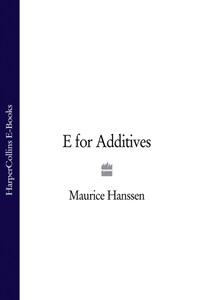THE BEST-SELLING, AWARD WINNING DEFINITIVE E NUMBER GUIDE
with Jill Marsden
B.Sc., Dip.Ecol., Dip.Ed.
Thorsons Element
An Imprint of HarperCollinsPublishers 1 London Bridge Street London SE1 9GF
The website address is: www.thorsonselement.com
First published October 1984
Twentieth Impression December 1986
Second edition (completely revised and substantially expanded) September 1988
© Maurice Hansen 1987
Maurice Hansen asserts the moral right to be identified as the author of this work
A catalogue record of this book is available from the British Library
All rights reserved under International and Pan-American Copyright Conventions. By payment of the required fees, you have been granted the nonexclusive, nontransferable right to access and read the text of this e-book on-screen. No part of this text may be reproduced, transmitted, downloaded, decompiled, reverse engineered, or stored in or introduced into any information storage and retrieval system, in any form or by any means, whether electronic or mechanical, now known or hereinafter invented, without the express written permission of HarperCollins e-books.
Source ISBN: 9780722515624
Ebook Edition © FEBRUARY 2016 ISBN 9780007381562
Version: 2016-01-05
HarperCollinsPublishers has made every reasonable effort to ensure that any picture content and written content in this ebook has been included or removed in accordance with the contractual and technological constraints in operation at the time of publication.
This new edition is dedicated to:
All those consumers and manufacturers who use the E code wisely to improve the quality of food and of health;
the many scientists, manufacturers and consumers who have provided invaluable technical information;
all those journalists and broadcasters who helped begin a food buying revolution with the first edition;
my patient and dedicated publishers;
my Research Assistant, Jill Marsden, B.Sc, who continues to triumph over the problems of organizing ever increasing quantities of often contradictory scientific information;
the distinguished and still crusading former Minister of Health, David Ennals, for his perceptive and kind foreword;
Leslie Kenton for her foreword to the first edition;
Elizabeth Brown and Angela Beazley for their word-processing skills, often under great pressure;
my family for their support.
There has been a revolution in the approach to what we eat. A series of reports have clearly established the link between food intake and health. It has been supported by doctors, pharmacists, dietitians and politicians. In 1985 a decision was made to establish an all-party Parliamentary Food and Health Forum, of which I am Chairman, and this has become one of the most active Parliamentary groups. Across the country there is concern at the fat and sugar content of food and a growing awareness that 30 per cent of adults in Britain are overweight. There is also a growing interest in colourings and artificial flavourings—in fact, in every type of additive. With Britain’s appalling record of avoidable diseases, there is now a major campaign linking diet and disease.
This growth in interest has led to a public demand for more information, and since 1962 the EEC has been issuing Directives on additives. Since the beginning of January 1986, most foods have carried a full list of additives, apart from flavourings, described by their E numbers on the package. A great step forward—providing you can fully understand the implication of the E number! For instance, I have aspirin sensitivity, and my wife is asthmatic. So we need to know, for both those conditions tend to bring in their wake sensitivities to certain common food preservatives and colours. The book describes these relationships fully, and in addition makes a convincing case for the full disclosure of ingredients and additives on products where they are not yet required to appear by law, such as in many types of confectionery, alcoholic drinks and medicines.
In 1984, following a great deal of research, Maurice Hanssen’s first edition of E for Additives was published. It was a tremendous success and was a bestseller for many months, along with Frederick Forsyth and Jeffrey Archer. It is still in great demand. It contains just enough essential information about the contents and effects (including adverse effects) of each product to enable the shopper to know just what they are being asked to buy.








